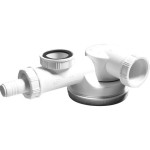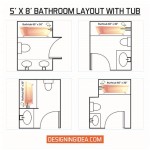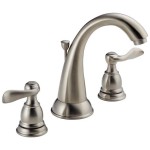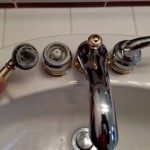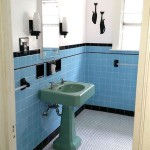Single Sink Bathroom Vanities Clearance: A Comprehensive Guide
Bathroom renovations or upgrades often require significant investment. One of the key components that can influence both the aesthetic and functional aspects of a bathroom is the vanity. Single sink bathroom vanities, designed for smaller spaces or secondary bathrooms, are frequently sought after, and finding them on clearance can significantly reduce the overall cost of a renovation project. This article explores the various aspects of single sink bathroom vanities available on clearance, providing information about styles, materials, considerations, and practical advice for making informed purchasing decisions.
The term "clearance" typically refers to items being sold at a reduced price to make room for new inventory or discontinued models. Clearance sales can offer substantial savings, allowing homeowners to acquire high-quality vanities at a fraction of their original cost. However, it's crucial to understand the reasons behind a clearance sale and to carefully evaluate the condition and suitability of the vanity before committing to a purchase.
Understanding the Scope of Single Sink Bathroom Vanities
Single sink bathroom vanities are generally designed to accommodate one sink basin and provide storage underneath. They are ideal for smaller bathrooms, powder rooms, or bathrooms where space is limited. These vanities come in a variety of sizes, styles, and materials, catering to diverse design preferences and functional needs.
Size is a critical factor to consider. Single sink vanities typically range from 24 inches to 48 inches in width. Measuring the available space in the bathroom is essential to ensure the chosen vanity fits comfortably without obstructing movement or access to other fixtures. The height of the vanity is another important consideration, particularly for users with specific needs or preferences. Standard vanity heights are typically around 30 to 36 inches.
Style variations are abundant. Traditional vanities often feature ornate detailing, raised panel doors, and decorative hardware. Contemporary vanities tend to have clean lines, minimalist designs, and sleek hardware. Transitional vanities bridge the gap between traditional and contemporary styles, offering a balanced aesthetic. Floating vanities, mounted to the wall without legs, create a modern, space-saving look.
Material choices greatly impact the durability, aesthetics, and cost of a vanity. Solid wood vanities, such as those made from oak, maple, or cherry, are known for their durability and timeless appeal. Engineered wood options, like plywood or MDF (Medium-Density Fiberboard), offer a more affordable alternative and can be treated to resist moisture. Vanity tops are commonly made from materials such as granite, marble, quartz, or ceramic, each offering different levels of durability, maintenance requirements, and aesthetic qualities.
Factors to Consider When Purchasing Clearance Vanities
Purchasing a single sink bathroom vanity on clearance presents an opportunity for significant savings. However, several factors should be carefully considered to ensure the purchase is a wise investment.
Firstly, inspecting the condition of the vanity is paramount. Clearance items may have minor cosmetic imperfections, such as scratches, dents, or blemishes. These imperfections may be acceptable if they are minimal and do not affect the structural integrity or functionality of the vanity. However, significant damage, such as water damage, warping, or structural cracks, should be a cause for concern.
Secondly, understanding the reason for the clearance sale is important. Was the vanity a discontinued model, excess inventory, or a returned item? Knowing the reason can provide insights into the potential risks associated with the purchase. Discontinued models may be difficult to match with replacement parts or accessories in the future.
Thirdly, assess the completeness of the vanity. Does it include all necessary hardware, such as knobs, handles, hinges, and mounting brackets? Are the sink and faucet included, or are they sold separately? Inquire about the warranty or return policy on clearance items. Some retailers may offer limited or no warranty on clearance products, while others may provide a reduced warranty period. Understanding the warranty terms is crucial in case of defects or malfunctions.
Fourthly, verify the dimensions and specifications of the vanity. Ensure it meets the size requirements of the bathroom and accommodates the existing plumbing connections. Check the location of the drain and water supply lines to ensure they align with the vanity's configuration. If necessary, consult with a plumber to determine if any modifications are required to accommodate the vanity.
Finally, evaluate the overall value proposition. Consider the original price of the vanity and the percentage of savings offered through the clearance sale. Compare the features, materials, and construction quality of the vanity to those of other options available at similar price points. Factor in the potential costs of repairs, replacements, or modifications that may be required.
Navigating the Process of Finding Clearance Deals
Finding single sink bathroom vanities on clearance requires a proactive approach. Several avenues can be explored to identify potential deals.
Visiting local home improvement stores and bathroom fixture retailers is a good starting point. Many retailers have designated clearance sections where they offer discounted items. Regularly checking these sections can reveal hidden gems. Enquire about upcoming sales or promotions that may include clearance items. Sign up for email newsletters or follow retailers on social media to stay informed about new clearance offerings.
Online marketplaces and e-commerce platforms offer a vast selection of bathroom vanities, including clearance options. Use search filters to narrow down the options based on size, style, material, and price. Read customer reviews to gain insights into the quality and reliability of the vanity. Pay attention to shipping costs and return policies, as these factors can significantly impact the overall cost of the purchase.
Consider visiting liquidation stores or auction sites. These venues often sell overstock or returned items at deeply discounted prices. However, the inventory can be unpredictable, and the condition of the items may vary. Inspect the vanity carefully before making a bid or purchase. Reputable online retailers often have "open box" sections where returned items or items with minor cosmetic damage are sold at discounted prices. These items are typically inspected and certified to be in good working condition.
Check with contractors and renovation companies. They may have surplus vanities from previous projects that they are willing to sell at a reduced price. Participate in online forums and communities dedicated to home improvement or bathroom renovations. Members may share information about clearance sales or offer used vanities for sale.
Attend home shows and trade shows. These events often feature exhibitors who are selling off display models or discontinued items at discounted prices. Negotiate with the seller to obtain the best possible price. Be prepared to act quickly, as clearance items are often available in limited quantities and may sell out quickly.
Key Considerations for Installation
Proper installation is crucial to ensure the longevity and functionality of a single sink bathroom vanity. Whether opting for professional installation or a DIY approach, several factors should be considered.
Before beginning the installation process, gather all necessary tools and materials. This may include a level, measuring tape, drill, screwdriver, wrench, plumber's tape, and sealant. Ensure the water supply is turned off before disconnecting the existing sink and plumbing fixtures. Carefully remove the old vanity, taking care not to damage the surrounding walls or flooring. Clean the area thoroughly to remove any debris or adhesive residue.
Inspect the subfloor for any signs of damage or rot. Repair or replace the subfloor as needed before installing the new vanity. Position the new vanity in place and ensure it is level. Use shims to adjust the height if necessary. Secure the vanity to the wall using screws or mounting brackets. Connect the plumbing fixtures, including the drain, water supply lines, and faucet.
Apply plumber's tape to the threads of the plumbing connections to prevent leaks. Tighten the connections securely, but avoid over-tightening, which can damage the pipes. Test the plumbing for leaks by turning on the water supply. If any leaks are detected, tighten the connections or apply additional plumber's tape. Apply sealant around the edges of the vanity to prevent water from seeping behind it.
If unsure about any aspect of the installation process, consult with a qualified plumber or contractor. Improper installation can lead to water damage, plumbing problems, or structural issues. Follow the manufacturer's instructions carefully when installing the vanity. These instructions will provide specific guidance on the proper installation techniques and hardware requirements.
In some cases, minor modifications may be required to accommodate the new vanity. This may involve relocating plumbing lines, adjusting the height of the drainpipe, or cutting a hole in the vanity for the sink. These modifications should be performed by a qualified professional.
Maintaining Your Single Sink Vanity
Proper maintenance is essential for extending the lifespan and preserving the appearance of a single sink bathroom vanity. Regular cleaning and care can prevent damage and keep the vanity looking its best.
Clean the vanity regularly with a mild soap and water solution. Avoid using abrasive cleaners or harsh chemicals, which can damage the finish. Wipe up spills immediately to prevent staining. Use a soft cloth to dry the vanity after cleaning.
Protect the vanity from excessive moisture. Ensure the bathroom is well-ventilated to prevent moisture buildup. Use a shower curtain or door to prevent water from splashing onto the vanity. Repair any leaks promptly to prevent water damage. Inspect the vanity periodically for signs of damage, such as cracks, chips, or water stains. Repair any damage as soon as possible to prevent it from worsening.
Apply a furniture polish or wax to the vanity periodically to protect the finish and enhance its appearance. Follow the manufacturer's instructions for proper application and maintenance. Avoid placing hot items directly on the vanity surface. Use coasters or trivets to protect the surface from heat damage. Avoid placing heavy items on the vanity countertop, as this can cause it to crack or warp.
Tighten any loose screws or hardware. Replace any damaged or worn hardware. Consider using a sealant or protectant on the countertop to prevent staining. Choose a sealant that is specifically designed for the countertop material. Regularly inspect the plumbing connections for leaks. Tighten any loose connections or replace worn parts.

Single Sink Vanities Bathroom Pottery Barn

Adelina 36 Inch Cottage White Sink Bathroom Vanity Marble Counter Top

Bathroom Vanities Thebath

Single Mirror Bathroom Furniture Luxury Vanity Sink Sets Clearance Cabinets And Vanities Medicine Cabinet With China Sanitary Ware Made In Com

60 Inch Single Sink Country Oak Bathroom Vanity Custom Top

Home Decorators Collection Maywell 24 In W X 19 D 38 H Single Sink Freestanding Bath Vanity Blue With White Cultured Marble Top Hd2024p2v19 Bu The Depot

Clearance 30 Wall Mounted Bathroom Vanity With Sink Combo Functional Drawer Solid Wood Mdf Board Ceramic Green Com

Soft Close Drawers Bathroom Vanities At Com

Left Bathroom Vanities With Tops At Com

22 Inch Narrow Depth Console Bath Vanity Custom Options
Related Posts

